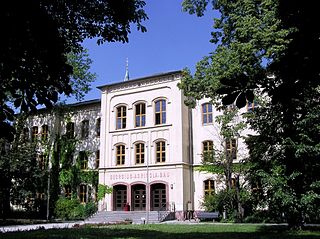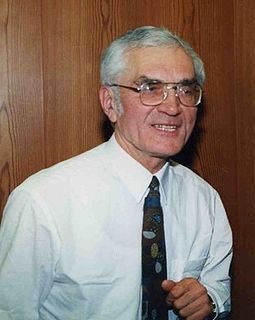
Georgius Agricola was a German Humanist scholar, mineralogist and metallurgist. Born in the small town of Glauchau, in the Electorate of Saxony of the Holy Roman Empire, he was broadly educated, but took a particular interest in the mining and refining of metals. For his groundbreaking work De Natura Fossilium published in 1546, he is generally referred to as the Father of Mineralogy.

The Ruhr, also referred to as Ruhr area, Ruhr district, Ruhr region, or Ruhr valley, is a polycentric urban area in North Rhine-Westphalia, Germany. With a population density of 2,800/km2 and a population of over 5 million (2017), it is the largest urban area in Germany. It consists of several large cities bordered by the rivers Ruhr to the south, Rhine to the west, and Lippe to the north. In the southwest it borders the Bergisches Land. It is considered part of the larger Rhine-Ruhr metropolitan region of more than 10 million people, which is among the largest in Europe.

The Ruhr University Bochum is a public research university located in the southern hills of the central Ruhr area, Bochum, Germany. It was founded in 1962 as the first new public university in Germany after World War II. Instruction began in 1965.
TU Dresden is a public research university, the largest institute of higher education in the city of Dresden, the largest university in Saxony and one of the 10 largest universities in Germany with 32,389 students as of 2018.

Graz University of Technology is one of five universities in Styria, Austria. It was founded in 1811 by Archduke John of Austria and is the oldest science and technology research and educational institute in Austria. It currently comprises seven faculties and is a public university. It offers 19 bachelors and 34 masters study programmes across all technology and natural science disciplines. Doctoral training is organised in 14 English-speaking doctoral schools. The university has more than 13,000 students, and approximately 2,000 students graduate every year. Science study programmes are offered in the framework of NAWI Graz together with the University of Graz.

Mine reclamation is the process of modifying land that has been mined to ecologically functional or economically usable state. Although the process of mine reclamation occurs once mining is completed, the planning of mine reclamation activities occurs prior to a mine being permitted or started. Mine reclamation creates useful landscapes that meet a variety of goals ranging from the restoration of productive ecosystems to the creation of industrial and municipal resources. In the United States, mine reclamation is a regular part of modern mining practices. Modern mine reclamation reduces the environmental effects of mining.

The Technische Universität Darmstadt, commonly known as TU Darmstadt, is a research university in the city of Darmstadt, Germany. It was founded in 1877 and received the right to award doctorates in 1899. In 1882, it was the first university in the world to set up a chair in electrical engineering. In 1883, the university founded the first faculty of electrical engineering and introduced the world's first degree course in electrical engineering. In 2004, it became the first German university to be declared as an autonomous university. TU Darmstadt has assumed a pioneering role in Germany. Computer science, electrical engineering, artificial intelligence, mechatronics, business informatics, political science and many more courses were introduced as scientific disciplines in Germany by Darmstadt faculty.

The University of Duisburg-Essen is a public research university in Duisburg and Essen, North Rhine-Westphalia, Germany and a member of the newly founded University Alliance Metropolis Ruhr. It was founded in 1654 and re-established on 1 January 2003, as a merger of the Gerhard Mercator University of Duisburg and the University of Essen.
Wilhelm Walcher was a German experimental physicist. During World War II, he worked on the German nuclear energy project, also known as the Uranium Club; he worked on mass spectrometers for isotope separation. After the war, he was director of the Institute of Physics at the University of Marburg. He was a president of the German Physical Society and a vice president of the German Research Foundation. He helped found the Society for Heavy Ion Research and the German Electron Synchrotron DESY. He was also one of the 18 signatories of the Göttingen Manifest.
The Gottfried Wilhelm Leibniz Prize, in short Leibniz Prize, is awarded by the German Research Foundation to "exceptional scientists and academics for their outstanding achievements in the field of research". Since 1986, up to ten prizes are awarded annually to individuals or research groups working at a research institution in Germany or at a German research institution abroad. It is considered the most important research award in Germany.

TU Dortmund University is a technical university in Dortmund, North Rhine-Westphalia, Germany with over 35,000 students, and over 6,000 staff including 300 professors, offering around 80 Bachelor's and master's degree programs. It is situated in the Ruhr area, the fourth largest urban area in Europe. The university is highly ranked in terms of its research performance in the areas of physics, electrical engineering, chemistry and economics. The university pioneered the Internet in Germany, and contributed to machine learning.

The Botanical Garden of TU Darmstadt is a botanical garden maintained by the Technische Universität Darmstadt.

A Dahlbusch Bomb is an emergency evacuation device for use in mining. In its original form it is a torpedo-shaped cylinder with a length of 2.5 metres, developed to transport trapped miners through boreholes after mining accidents. It does not contain explosive: it was called a "bomb" because of its shape.

Erich Barke is a German emeritus professor of microelectronics. From 2005 to 2014, he was president of the Gottfried Wilhelm Leibniz Universität Hannover. Until December 2014, he was also president of the Niedersächsische Technische Hochschule (NTH).

The German Mining Museum in Bochum or DBM is one of the most visited museums in Germany with around 365,700 visitors per year (2012). It is the largest mining museum in the world, and a renowned research establishment for mining history.

The Westsächsische Hochschule Zwickau - University of Applied Sciences Zwickau is a vocational university of about 3300 students located in Zwickau. Saxony, Germany. It offers Bachelor's, Master's and traditional German Diplom degrees in four core areas: Technology, Economics, Arts, and Life Sciences. The university also has further campuses in Markneukirchen, Reichenbach im Vogtland and Schneeberg.

Content in this edit is translated from the existing German Wikipedia article at de:Michael Roth (Kybernetiker); see its history for attribution.

The governments of Germany and Mongolia co-founded the German-Mongolian Institute for Resources and Technology, based on an agreement which was signed in October 2011 by Mongolian President Tsakhiagiin Elbegdorj and German Chancellor Angela Merkel. GMIT started with its first 35 students in 2013. On June 20, 2018 the first graduation of Bachelor students took place.

Jürgen Kretschmann is a German economist and university president.

DMT-Gesellschaft für Lehre und Bildung mbH (DMT-LB), based in Bochum, is a collective association of the German coal mining industry and acts as the funding organisation of Deutsches Bergbau-Museum Bochum and Technische Hochschule Georg Agricola. It was established as the Westfälische Berggewerkschaftskasse (WBK) in 1864 and merged with the Steinkohlen-Bergbau-Verein (Stbv) and Bergbau Forschung GmbH under the auspices of DeutscheMontanTechnologie e.V. (DMT) in 1990.




















